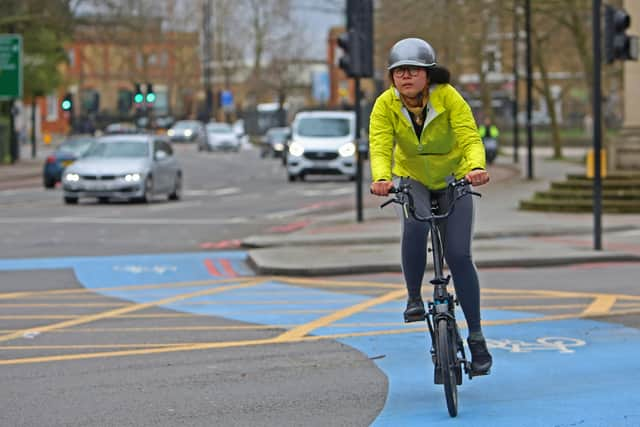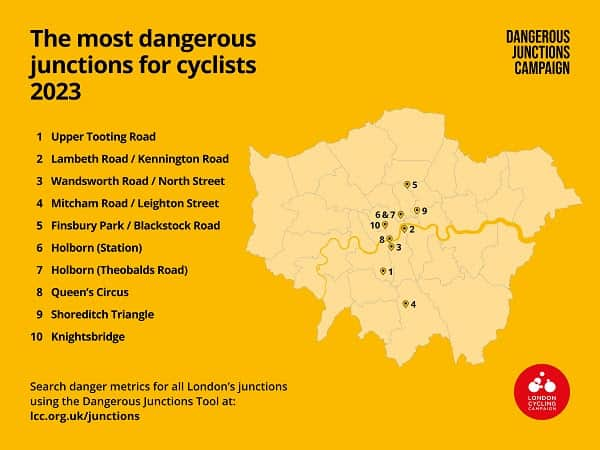London Cycling Campaign: What are the capital’s most dangerous junctions for cyclists?
and live on Freeview channel 276
London’s most dangerous junctions for cyclists and pedestrians in 2023 have been revealed, as the campaign group behind the project calls for Sadiq Khan and Transport for London (TfL) to speed up their efforts to improve road safety.
Compiled using the latest emergency services ‘Stats19’ collision data, London Cycling Campaign’s (LCC) list identifies the cluster of junctions where Ansell Road, Derinton Road, Price Close and Lessingham Avenue intersect with Upper Tooting Road in south London as the most lethal for cyclists.
Advertisement
Hide AdAdvertisement
Hide AdRegularly used by drivers as “cut-through routes”, despite around 3,000 cycling journeys made in the area daily, the LCC said 11 serious injuries and 18 slight injuries to cyclists have been recorded at the junctions in the last five years.
The Kennington Road and Lambeth Road junction was next, with one fatal collision, two serious and five slight, followed by Wandsworth Road and North Street, with one fatal, three serious and seven slight collisions.


The LCC's map also includes data on the most dangerous junctions for pedestrians. Number one is identified as the Southall High Street and Avenue Road intersection, where it says “a 'ratrun' meets a congested shopping street with high footfall and restricted sightlines”.
Mr Khan and TfL have committed to a ‘Vision Zero’ by 2041, by which date they are aiming for all deaths and serious injuries to be eliminated from the transport network, though the LCC is calling for works to be sped-up to improve safety for cyclists and pedestrians at junctions in the capital.
Advertisement
Hide AdAdvertisement
Hide AdThis comes following several cyclist deaths in London in just the last few months, including Gao Gao, a 36-year-old mother of two, and Harry Webb, 27, who was due to begin a master's degree.
Tom Fyans, chief executive at London Cycling Campaign, said: “Behind this horrific data are hundreds of stories of families torn apart by tragedy and lives changed forever.
“The mayor has committed to a 'Vision Zero' for London by 2041 – but that would mean over 17 years more fatal and serious collisions for Londoners – we need to be faster and bolder.
“Whilst cycling and indeed walking and wheeling remain relatively safe, healthy ways of getting about London, TfL, the mayor and our boroughs must move faster and be bolder on road danger to stem the human cost posed by dangerous junctions and poor road designs.”
Advertisement
Hide AdAdvertisement
Hide AdWhere are London’s most dangerous junctions for cyclists?
The LCC has identified the following junctions are the most dangerous for cyclists:
Upper Tooting Road
Lambeth Road & Kennington Road
Wandsworth Road & North Street
Mitcham Road & Leighton Street
Finsbury Park & Blackstock Road
Holborn (Station)
Holborn (Theobalds Road)
Queen's Circus
Shoreditch Triangle (Great Eastern Street & Curtain Road)
Knightsbridge (incl. Albert Gate)


Commenting on the Upper Tooting Road cluster specifically, Dr Cleo Kenington, co-chair of Bicycle Users Group and consultant surgeon at St George's Hospital, Tooting, said: “The Tooting section of the CS7 Cycle Superhighway is the most popular cycle route used by St. George’s Hospital staff according to the hospital’s Bicycle Users Group survey.
“However, that survey also reports of the serious dangers in using CS7. The dangers listed include: the lack of maintenance of CS7; cars pulling out across CS7 at junctions; the lack of enforcement of illegal car parking; the absence of/damage to cycle wands; and illegal turns by cars into ‘no left turns’ junctions.
“These problems make cycling to work by staff from St George’s Hospital an unnecessarily risky mode of active travel. Improvements along that section are urgently needed to reduce the number of collisions.”
Advertisement
Hide AdAdvertisement
Hide AdA TfL spokesperson said: “Any death or serious injury on the roads is one too many and we are determined to end the devastating consequences of road danger by working with London boroughs to make roads safer, including at junctions.
"We have reduced danger at 44 junctions across London as part of our Safer Junctions programme and we continue to work on designs for a significant number of further locations in collaboration with our partners in the London Boroughs, including many of those highlighted by this data. We welcome London Cycling Campaign's research and will be working closely with campaigners, councils and local communities across the capital on our investment in new infrastructure over the coming years."
Walking and cycling commissioner Will Norman said: “The mayor and I are committed to eliminating deaths and serious injuries from London’s streets. We are delivering high-quality cycle routes and investing in work that makes dangerous junctions safer – we have a strong track record, having almost quadrupled the size of London's cycleway network since 2016, from 90km to 350km this year.
"We have also accelerated our 20mph speed limit programme and are tightening the Direct Vision Safety standard for HGVs."
Comment Guidelines
National World encourages reader discussion on our stories. User feedback, insights and back-and-forth exchanges add a rich layer of context to reporting. Please review our Community Guidelines before commenting.
